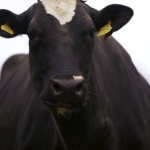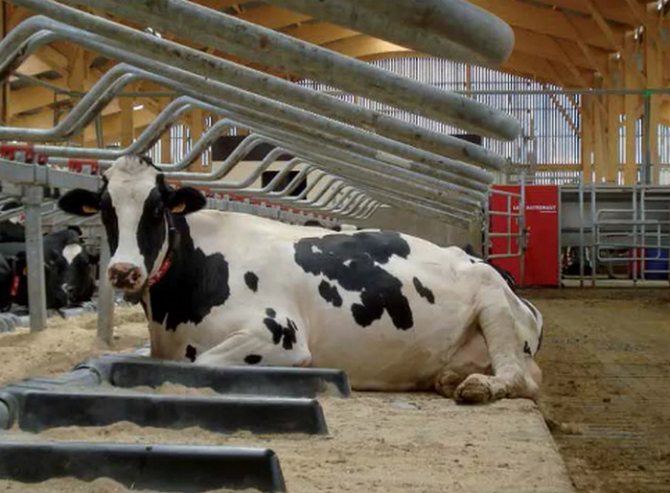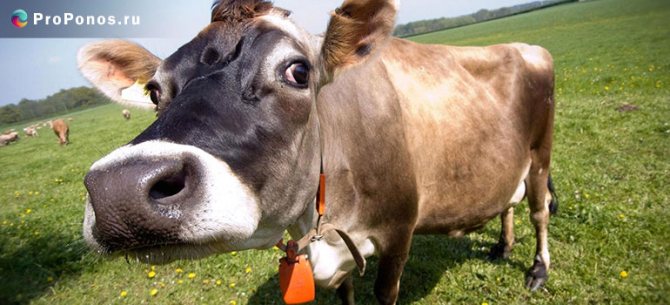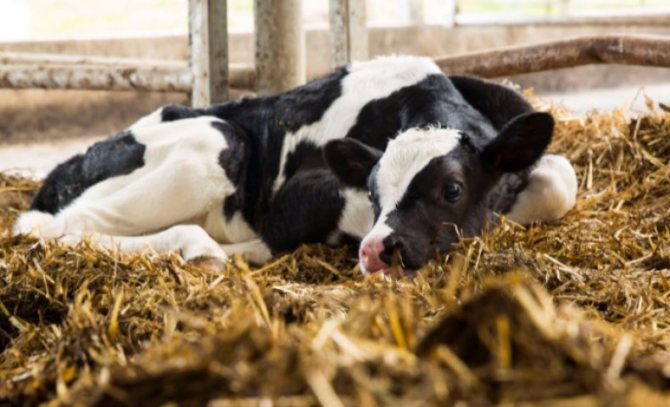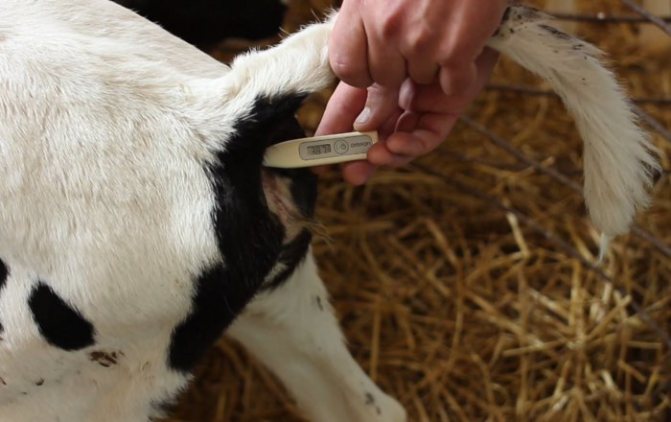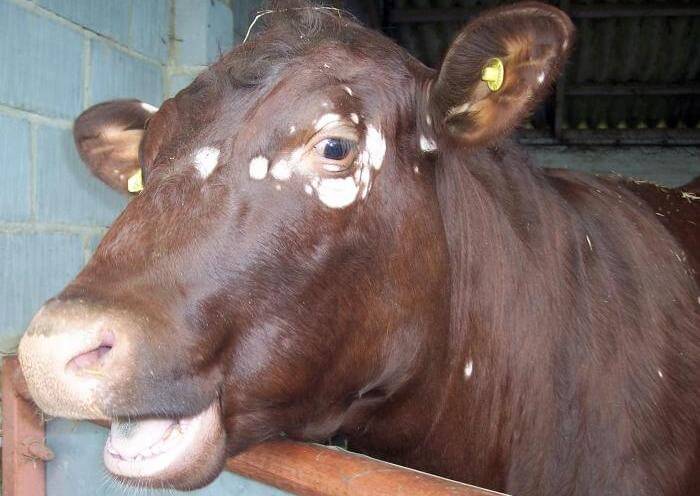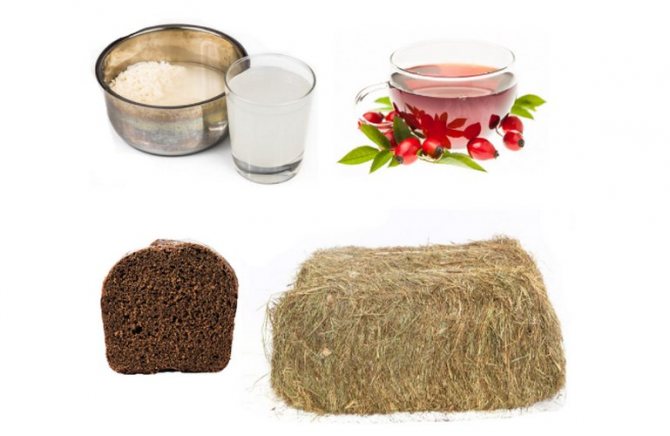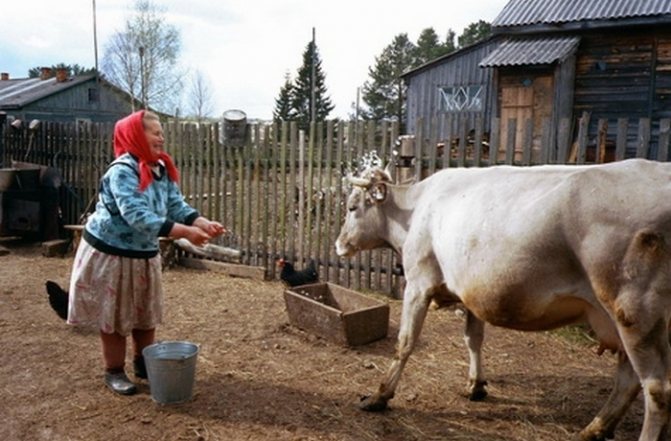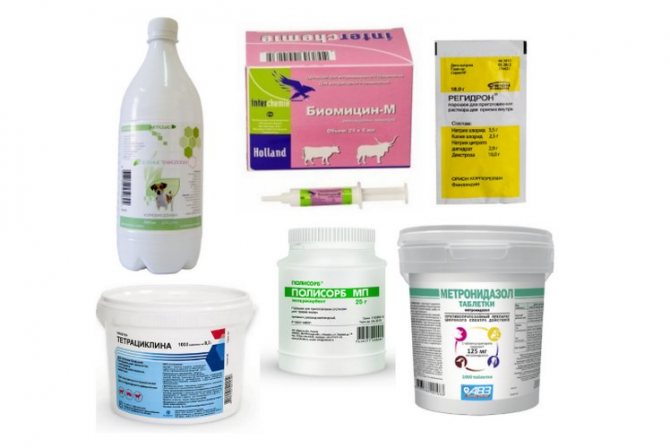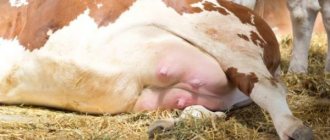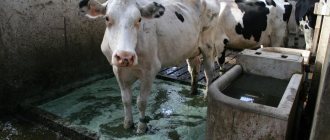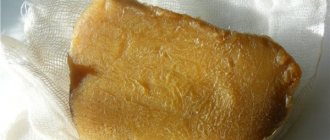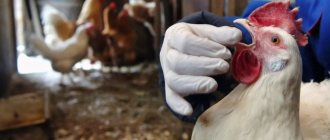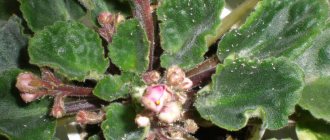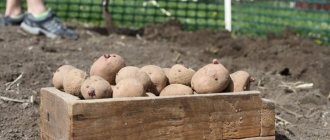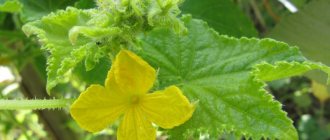Bacteria can cause diarrhea in a cow. This disease can greatly affect the health of livestock and cause damage to the entire economy. The diarrhea virus, having entered the animal's body, can lead to the development of escherichiosis. Diarrhea is fatal in 70%. Despite the fact that pharmaceutical companies are developing new drugs, viral diarrhea in cattle is one of the main causes of high mortality in agricultural enterprises.
Signs
The main symptoms of diarrhea in a cow are:
- increased stool (bowel movements can occur from 5 to 12 times a day);
- changes in the consistency, color and odor of feces (they can become slimy, watery, foamy, with blood impurities);
- lethargy, apathy;
- refusal of feed.
Long-term stool disorder is accompanied by dehydration, which, in turn, is manifested by:
- dry mucous membranes;
- sinking eyes;
- lack of urination;
- slow heartbeat.
Medication for diarrhea
As a rule, the treatment of diarrhea is not complete without special medications. There are many drugs on the market today that have a quick effect on diarrhea. Antibiotics are most commonly used. They kill viruses that have entered the body and have antiseptic properties. Syntomycin is one of the commonly used antibiotics. It is given to a cow 3 times a day, 200 grams for 2-4 days. It is also permissible to use sulfa drugs (for example, norsulfazole).
To overcome a severe form of diarrhea, it is necessary to use strong medications, such as trisulfone, metronidazole. If you give herbal teas, keep in mind that traditional treatment is recommended only for mild diarrhea.
Cleansing the colon in cows with an enema is another way to effectively combat diarrhea. For these purposes, a klystyr mug with a rubber tube about two meters long is used. The intestine is washed with infusions of herbs (alder, sage, nettle), potassium permanganate or saline solution. The volume of fluid, depending on the degree of diarrhea and the weight of the cow, ranges from 10 to 20 liters.
The reasons
The causes of diarrhea in cows can vary. Diseases that trigger diarrhea include:
- poisoning;
- feed allergy;
- dysbiosis;
- lack of trace elements;
- helminthic invasions;
- infectious diseases (coronavirus infection, colibacillosis, rotavirus infection).
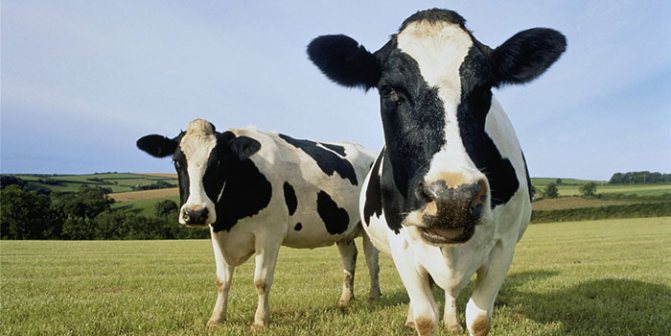
Poisoning
Poisoning in cows is a consequence of eating:
- poisonous grass or acorns;
- inedible mushrooms;
- green potatoes;
- a lot of salt;
- moldy food.
In addition to diarrhea, animals may experience:
- bloating;
- vomiting;
- oppression;
- wobbly gait;
- increased breathing and accelerated heart rate;
- increased salivation;
- constriction or dilation of the pupils;
- redness and ulceration of the mouth;
- cyanosis of the skin.
Food allergy
Food allergy is a disease widespread among young animals and characterized by the presence of hypersensitivity to certain foods, manifested by damage to the digestive tract, skin, and blood vessels.
The main reasons for the development of pathology are:
- the predominance of glycoproteins and protein in the diet that are not suitable for feeding young animals;
- the presence of drugs and chemicals that are unusual for the animal's body in feed;
- high contamination of the feed with microorganisms or the presence of fungi in it.
And the predisposing factors are:
- insufficient barrier and enzymatic function of the digestive tract;
- abuse of antibacterial drugs, provoking digestive disorders and changes in the composition of the intestinal microflora.
In addition to diarrhea, a cow may experience:
- stomach ache;
- nausea and vomiting;
- constipation.
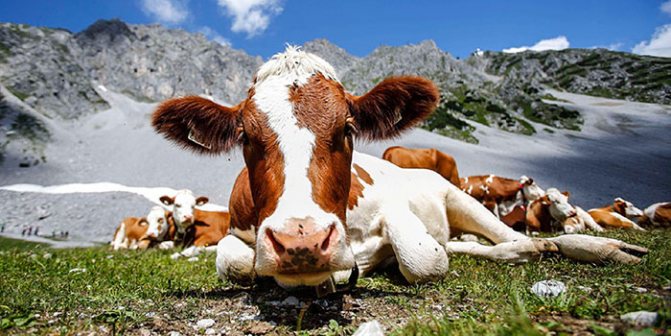

Dysbacteriosis
Dysbacteriosis is one of the main causes of diarrhea in cows. Pathology develops against the background of a lack of fiber (for example, when switching from conventional feeds to green ones) and is accompanied by a decrease in the proportion of useful microflora in the intestine, which, in turn, leads to stool disorders.
Preventive actions
After the treatment of diarrhea, the animal recovers for a long time, so the following should be considered:
- you need to adhere to hygiene and sanitary standards;
- it is recommended to get vaccinated on time to exclude the virus;
- newborn bulls are provided with colostrum;
- it is better to separate young livestock from each other, they should not be near the manure of other animals;
- the necessary vitamins and minerals must be present in the feed;
- as a preventive measure, the calves are given yogurt or lime water.
Farmers must monitor the health of animals, especially at a young age, because this is the most difficult period, when many deaths often occur. Any disease is easier to prevent than to cure for a long time and persistently!
What if a cow has diarrhea?
The scheme for treating diarrhea in cows at home depends on the reasons that led to the development of the pathology.
If the animal has eaten an inedible plant, a 0.5% solution of acetic acid in water is injected into its stomach (its volume should be 2 liters). In addition, gastric lavage is performed with a weak solution of potassium permanganate, as well as injections of glucose and a 10% solution of Urotropin intravenously.
For your information. The first two days from the moment of poisoning, the cow is soldered with broth and water (the animal is not given food).
To neutralize the action of nitrates, methylene blue is used, and then the stomach is washed with a probe.
When overeating beets, gastric lavage is performed (with a pale pink solution of potassium permanganate), insulin is injected subcutaneously, and 5% sodium chloride solution is administered intravenously.
In case of strong depression of the central nervous system in case of poisoning, caffeine is administered. With excessive agitation, chloral hydrate is used intravenously.
Attention! It is unacceptable to treat severe poisoning without consulting a veterinarian - only he can say that you can give a cow for diarrhea.
In the presence of food allergy, the animal is transferred to a special diet and supportive therapy is prescribed. In the exacerbation stage, Diprazine, Diphenhydramine, Hydrocortisone, Cortisone, calcium chloride and gluconate are used. Vitamin therapy is used to accelerate the recovery of the digestive tract.
In the presence of dysbiosis, Bakril, Lactobacterin, Enterobifdil are used.
The lack of trace elements is eliminated by their introduction into the diet.
Helminthiases are treated with antihelminthic drugs.
In the treatment of coronavirus infection, the following are used:
- hyperimmune serum, created on the basis of biomaterials collected from donor animals;
- milk containing anti-hemagglutinins from the coronavirus;
- colostrum vaccinated cows;
- isotonic solutions;
- a mixture of saline and hay infusion;
- antibacterial drugs.
Bloody diarrhea
Diarrhea with blood is an alarming symptom, indicating ulceration of the intestinal mucous membranes and internal bleeding. With such a symptom, you can not postpone a veterinarian examination.
A common cause of blood-streaked feces is infection with coccidiosis (helminthic infestation). Parasites enter the body of a cow by the oral route: when drinking water from dirty reservoirs.
A severe viral or bacterial infection can also cause blood in the stool.
The main symptoms
Obviously, the main symptom of diarrhea is liquefied stool. Since they are very liquid and watery, with prolonged diarrhea, the body becomes severely dehydrated and all the beneficial elements are washed out, which is the most dangerous for the pet.
The state of the animal with varying degrees of dehydration:
- loss of water up to 4.5% - the animal can stand on its feet, depression is observed, increased urination;
- loss of water up to 8% - the animal can still stand on its feet, however, there are dull eyes, loss of skin elasticity, dry nose and mouth;
- loss of water up to 10.5% - the above manifestations are aggravated, the animal cannot stay on its feet, there is a cold snap of the limbs and ears, at this stage, intravenous therapy can save the animal;
- loss of more than 11–12% - with this degree of dehydration, it is almost impossible to save the animal, since a state of shock and death occurs.
Read also: Compound feed for cattle (cows, calves): types and composition
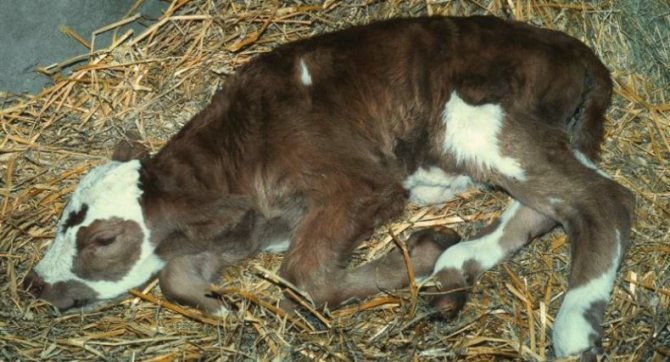

The clinical picture of viral diarrhea:
- If the causative agent is Escherichia coli, there is a very abundant discharge. The disease has a fleeting nature, causes a general infection of the body, without treatment it ends fatally in almost 100% of cases. Usually, E. coli infection occurs in newborn calves 2-7 days of age.
- When infected with rotavirus, profuse diarrhea occurs - the diarrhea practically does not stop, while the stool is very watery or completely composed of water, painted in a light yellow or whitish color, and has a sour odor. Other symptoms include: The calf refuses to eat, becomes very weak and lethargic, and has an increase in temperature.
- With the defeat of the coronavirus, profuse diarrhea also occurs, but the feces have a greenish-yellow color, sometimes blood impurities appear. The temperature can be normal or low. With prolonged absence of treatment, ulcers may appear in the oral cavity, saliva turns into foam.
Treatment of diarrhea of a viral nature is much more difficult and is determined by the degree of damage to the body and the type of pathogen.
What is dangerous for a cow
The occurrence of diarrhea in cattle should be alarming because of the consequences of:
- Rapid dehydration of the body occurs, which leads to a malfunction of all organs.
- With frequent urge, the intestinal walls are constantly in tension, and this causes bleeding, if you do not start treatment, it can be fatal.
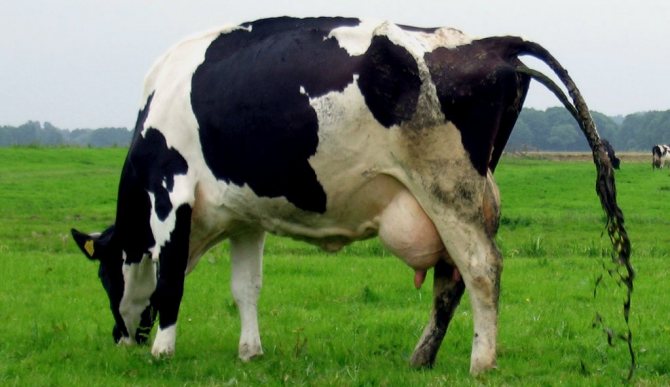

Basic treatments for calves
At the first sign of indigestion in a young individual, treatment should be started immediately. To this end, the fluid intake of the animals is increased. The liquid should be energetically saturated and contain glucose or dextrose, as well as electrolytes. Antibiotics are used in parallel.
Calves, which are found to have loose stools, are prescribed diet food. Colostrum is replaced with salt solutions. Antitoxic serum is used to stop escherichiosis. In some cases, they resort to using a bacteriophage. In addition, when determining the level of sensitivity of Eschechirii, they resort to the use of chloramphenicol, biomycin, terramycin and tetracycline. They are mixed into colostrum or milk.
The list of antibiotics prescribed for colibacteria includes phthalazole, sulfazole, sulfamide, sulfadimezin, furazolidone and furazidin.
In the fight against colibacteria, the method of feeding calves with fermented milk proved to be excellent. The acidic environment stops the proliferation of harmful Escherichia coli.
In the event of a viral infection of the calf, it is necessary to ensure the production of antibodies against the disease in the body of the cow that is feeding the baby. With her colostrum, she will pass on the necessary immune bodies that fight the virus.
The rule is that calves should receive such colostrum immediately after birth.
The calf should be kept warm during illness.
Epizootology
The disease of bacterial etiology affects the spring of young age predominantly 10-60 days. This is the most preferred time for mass calving. By the time the rumen begins to function, the calf may be grazing or eating cut grass. Weakened cubs are the first to fall ill - hypotrophic. The predisposing factors for the onset of salmonellosis are uncomfortable conditions of detention, inadequate feeding. Insects and small rodents become carriers of microbes.
What is the risk of diarrhea
As mentioned, diarrhea in calves does not go away by itself and, in the absence of intervention, leads to the death of the animal. Negative consequences can accompany an individual even in the future, worsening its well-being and physiological development.
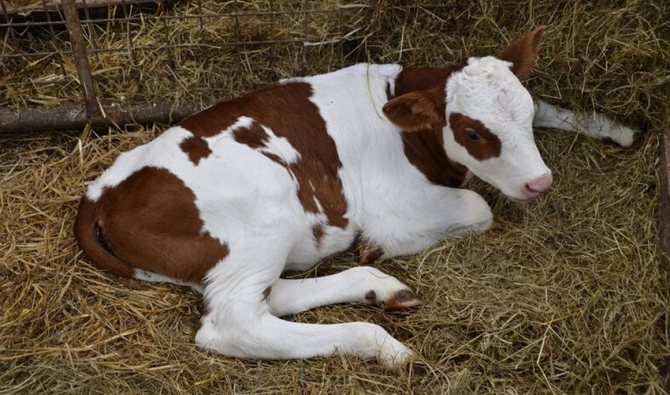

A good appetite is often not restored at all, so such an individual will gain weight more slowly than others.
Important! Cows with diarrhea at calf age have a lower milk yield.
Bacterial infections in calves
Various types of bacteria can cause intestinal upset in young animals.
Colibacillosis
Usually observed in newborn calves, the weakest with a low acidity of the body, a low content of gamma globulins in the blood. The reasons can be a chronic illness of the mother, a deficiency of vitamins, poor liver function, as well as such banal prerequisites as improper maintenance, unsanitary conditions.
The symptoms of the disease are:
- temperature increase;
- intense gas formation;
- painful colic;
- lethargy, lethargy, milk refusal;
- liquid stool of a characteristic yellow hue, subsequently having a gray-white color, containing flakes of foam, an admixture of mucus and blood with a repulsive odor.
When you press on the abdominal wall, the animal experiences pain, its abdomen is pulled up or swollen, the eyes sink. For a short time, the temperature can rise to 41 degrees, the coat looks tousled and dull.
Treatment can lift the calf to its feet if started at the first sign of infection. Coliphage, Gamma globulin, immune serum are used as a medicine. Previously, the baby is given a soda solution in the amount of 30 ml. To restore the water balance, the young are fed with an isotonic solution with a chicken egg mixed into it. When treating, children are separated from the mother and watered by hand from a bottle.
Of the antibiotics for intestinal disorders, it is recommended to give animals Ampicillin, Tetracycline, Hektamycin and Spektam in combination with milk.
To maintain a normal intestinal environment, probiotics are shown - Bifidumbacterin and Enterobifidin. In addition, young animals are fed several times a day with enveloping decoctions of flax, oats and rice, and salt solutions. Decoctions of sage, oak bark, chamomile, horse sorrel will help to strengthen the immune system.
Salmonellosis
The disease is caused by the bacteria Salmonella, and the main reason is the unsanitary conditions of the calves or their large number in the same area. Worst of all, animals who have recovered from this infection remain its carrier and pose a danger to healthy livestock. Infection occurs through the digestive system.
Signs of pathology:
- the temperature rises (from 39 to 42 degrees);
- lack of appetite;
- mucus is secreted from the nose;
- diarrhea begins on the second day, later feces can flow out arbitrarily.
In the acute form, cough, runny nose, signs of arthritis are added to these symptoms. In this position, the calves need complex therapy, which consists in administering polyvalent antitoxic serum and taking antibacterial agents such as Neomycin, Levomycetin, Chlortetracycline (Tetracycline). Synthomycin is given with milk.
The causative agent is a bacterium of the Clostridium family, which produces the strongest intoxication in calves, and therefore their death occurs, if attempts are not immediately made to cure.
Severe symptoms of the disease:
- high temperature (41-42 degrees);
- impaired coordination of movements;
- muscle spasms;
- rapid pulse and breathing;
- poor appetite;
- brown diarrhea with blisters and blood.
At the initial stage, the use of antibiotics-sulfonamides, antitoxic serum (polyvalent, aluminum hydroxide vaccine) is effective for treatment. To restore the gastrointestinal tract, acidophilus, water and milk acidified with hydrochloric acid, and gastric juice are used.
In addition to enterotoxemia, this anaerobic microorganism can cause tetanus in livestock, malignant edema, in which the body temperature does not rise, but also depletion of the body and digestive problems are observed. With botulism, calves also suffer from diarrhea.
What absolutely can not be done with diarrhea
With loose stools in a calf, it is strictly prohibited:
- uncontrolled feeding - for good digestibility of food, animals must have a clear regimen;
- cold milk;
- compound feed and other foods with a high salt content;
- overfeeding of young animals - calves are not adapted to stomach overload;
- keeping in a damp, cold room.
The air in the barn must be well circulated. Regularly clean and disinfect the equipment of your wards so that pathogens do not multiply.
Diagnostics
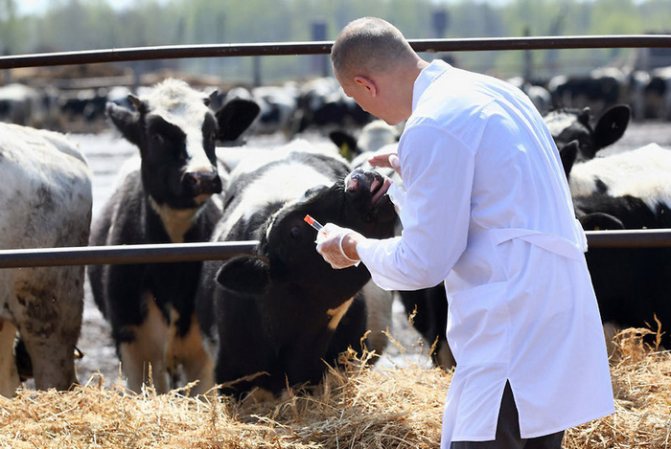

In order for the veterinarian to be able to find out the nature of the disease, he needs to examine the livestock:
- Measure your body temperature.
- Find out what and how the cow eats.
- Ask if there have been any changes in the diet the day before.
- Find out other symptoms, frequency of diarrhea.
- Examine the feces: color, consistency.
- Listen to breathing.
Based on the examination result, the doctor diagnoses and prescribes treatment.
Why does postpartum diarrhea occur?
The animal after calving needs particularly careful care. Many cows suffer from digestive upset after giving birth. However, farmers often do not know the basic rules for feeding a cow during this period.
The main factor causing diarrhea is poor quality feed. The nutritional value of the silage is key. Deficiency of vitamins and minerals can lead to disruption of the digestive system.
If you experience symptoms of diarrhea, it is best to see your veterinarian. The cause of diarrhea can be pathogenic microorganisms. It is necessary to check the faeces of the animal for the presence of parasites and harmful bacteria.
What to do if diarrhea lasts more than a day? The cow suffers from a lack of water and micronutrients. You can help a weakened animal with a sweet drink based on honey and sugar.
To prepare a healing drink, add st. a spoonful of sugar. Honey has a bactericidal effect. Look at the behavior of the animal. If the condition remains severe, it is necessary to show the cow to a specialist.
Prevention
For the prevention of diarrhea in a cow, it is important to observe the following recommendations:
- Keep the cow's stall and utensils clean.
- Vaccinate on time.
- Preventive deworming (fight against parasites).
- Walking is carried out only on prepared pastures.
- Feed with fresh hay, do not allow frozen grass to enter the feed.
- Balance the diet according to the age and body weight of the cow.
If you follow the tips and recommendations, the risk of an unpleasant and dangerous symptom in the form of diarrhea will be significantly reduced.
Pathogenesis
Pathogenesis consists in the penetration of paratyphoid bacteria by the oral route, reproduction, production of endotoxins, which cause irritation and inflammatory processes in the intestine. If the calves have a protective barrier, salmonella cannot break into the lymph or bloodstream, and is excreted in the feces without causing significant harm to the calf.
In weak animals, the microbe enters the bloodstream, spreads to all tissues and organs, causing septicemia. The harmful effects of Salmonella on the calf are the intake of nutrients and the release of toxins, which further weaken the body and become easy prey for other contagia.
The permeability of the vascular walls increases, erythrocytes leave the vessels, are placed in the tissues, disrupting their nutrition. Poisonous metabolites interfere with the functioning of the calf's nervous system.
In combination with developing diarrhea, the release of blood components from the vessels leads to dehydration. Hemorrhages appear on the mucous membranes and serous membranes. Kidneys, spleen, liver, calf joints fail. In pregnant cows, the uterus becomes inflamed, the fetus is affected, which leads to an abortion. With a chronic course, ulcers develop in the intestines of the calf. Constant irritation causes recurrent digestive upset.
The propensity to morbidity depends not so much on the virulence of Escherichia, but on the functional development of the organs and systems of the calf. In the absence of colostrum immunoglobulins, the banal microflora attaches to the intestinal wall, enters the bloodstream, triggering the development of septicemia. Crane cells that allow gamma globulin protein molecules to pass through cease to function 6–8 hours after calving. If during this time the calf does not receive colostrum, its chances of survival are minimal.
If the udder is not dirty, it will live
When nothing prevents the reproduction of E. coli in the blood, they begin to compete with each other, some of them die, releasing toxins that poison the calf's body. In this case, the newborn dies of colibacillosis without pronounced symptoms.
If the calf received colostrum, but with a delay, immunoglobulins prevent the active division of Escherichia in the blood. But the cells of the pathogen that have grown stronger in the intestine continue to multiply, releasing poisoned metabolites into the lumen of the alimentary tube. Poisons act on smooth muscles, it contracts, trying to expel toxic chyme outside. The calf loses water and salt. Dehydration develops.
How to treat diarrhea with medication
Calf diarrhea - how to treat it? Noticing the slightest health problems in the baby, it is best to consult a doctor. A veterinarian called at home will determine the cause, diagnose and prescribe treatment. If diarrhea is triggered by viruses or food poisoning, it is likely to be medication. There are main types of medicines.
- Oral rehydration preparations. Combat dehydration and restore salt loss. Contain potassium, sodium, chlorine, glucose, sucrose, etc. Sold in the form of powders, from which solutions are made. They act quickly and without side effects. They have no contraindications.
- Sorbents. Prevent intoxication of the body.
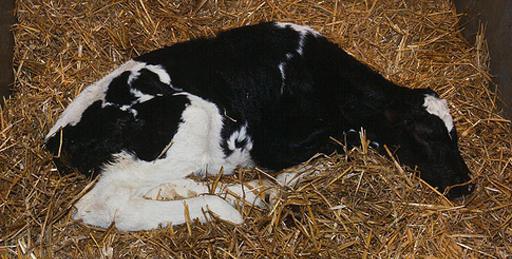

- Drugs that slow down intestinal motility. The absorption of digested food is almost not affected, but tone and motor skills are reduced.
- Enzymes. They are prescribed in cases where diarrhea is caused by enzymatic disorders of the digestive system.
- Probiotics.Correct the physiological balance of the intestinal microflora. There are microbial and non-microbial origin.
Complication and consequences
Any disease in calves, in the absence of treatment, can be fatal, because the development of pathology passes rapidly.
Various ailments are fraught with all sorts of complications that logically lead to the death of the animal:
- In viral diseases, frequent complications are eye damage (keratoconjunctivitis) and meningoencephalitis. When the lungs of an animal are involved in the process, this can lead to blockage of the bronchi, suffocation and natural death.
- No less terrible is encephalitis, which can be observed as a result of infection with infectious rhinotracheitis. Sick calves become agitated, aggressive, however, very soon they may have seizures, coordination of movements is impaired and paralysis occurs.
- With colibacillosis in young animals, the lungs and joints can be affected, lameness appears, their body is quickly depleted and dehydrated. Before death occurs, calves can suffer from several days to several weeks, it all depends on the degree of damage.
- The danger of enterotoxemia consists in multiple hemorrhages, inflammation of the ileum and small intestine with concomitant tissue necrosis.
It turns out that the only way to save the animal is a timely visit to the veterinarian.
Views
Infections are often the cause of severe disorder. The most common ones are:
- Escherichiosis.
- Rotavirus infection.
- Coronavirus infection.
- Cryptosporidiosis.
Escherichiosis is caused by one of the strains of Escherichia coli. When it enters the small intestine, the bacteria provoke severe food poisoning. As a result of the rapid multiplication of pathogenic flora, toxins accumulate in the body. The animal almost always dies due to intoxication and severe dehydration, if treatment is started untimely.
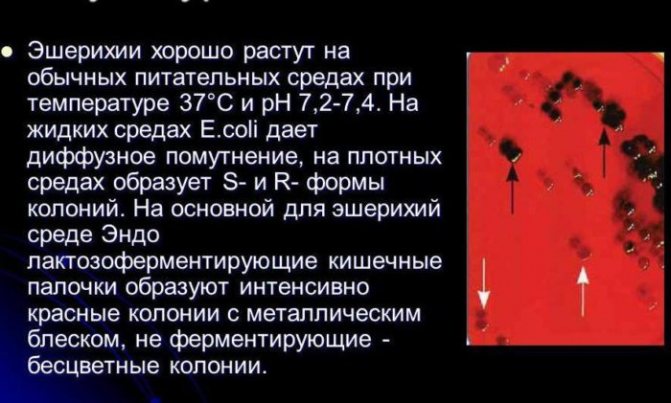

Escherichiosis disease is caused by one of the strains of E. coli
Rotavirus most commonly infects newborns. This disease is treatable if started on time. In the absence of therapy, calves usually die due to dehydration.
Coronovirus and cryptosporidiosis are equally dangerous diseases that affect calves from two weeks of age. The prognosis is poor if you do not immediately respond to the symptoms of the disease. The body of young individuals very quickly loses fluid; death in this case also occurs from dehydration.

